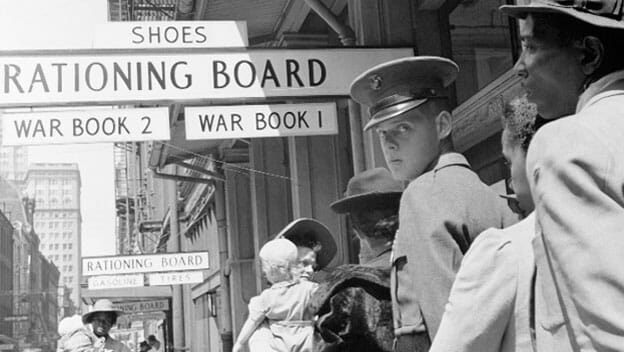If you were asked to picture people lined up at a grocery store with ration books in their hands, you would probably imagine people in war-torn Europe. However, during World War II, government-issued ration books were a very real part of American life.
To distribute food and other items that could be in short supply due to the war effort and also to create a sense of unity, the federal Office of Price Administration (OPA) established a rationing system for the nation’s citizens.
For example, on the National World War II Museum website, you can see an image of the warning page from War Ration Book One.
Punishments ranging as high as Ten Years’ Imprisonment or $10,000 Fine, or Both, may be imposed under the United States Statutes for violations thereof arising out of infractions of Rationing Orders and Regulations.
Ration book covers included symbols of military aircraft and tanks to remind citizens of their purpose.
Initially, rationing began with gasoline and tires, as the government geared up to transport American troops overseas.
Nationwide, gasoline rationing began Dec. 1, 1942. A typical American with “nonessential” driving needs was allowed enough gasoline for roughly 3,000 miles per year. As a result, families put their vacation road trip plans on hold indefinitely.
Several months later, the rationing program expanded to include food and food products. Many processed and canned foods were in short supply because they were being reserved for the troops, and the transportation of fresh foods was becoming limited due to gasoline and tire rationing. In an effort to keep the distribution of food fair and equal (in other words, to discourage a black market), the OPA issued monthly ration books to every American.
Get Instant Electrical Power In A Convenient, Portable Briefcase!
The books contained removable stamps good for specific items such as sugar, meat, cooking oil and canned goods. A shopper could purchase a rationed item only with the proper stamp. Once you used your stamps for the month, you could not buy any more of those particular foods that month. As a result, menu planning and menu creativity became an essential part of everyday life.
The system was complicated with points allotted to each item on the list.
Each household member received 16 points of red stamps and 48 points of blue stamps per week. Blue coupons were for canned and bottled fruits and vegetables, and red coupons were for meats, hard cheese and fats. Grocers displayed the ration points for items on their shelves, and shoppers would pay the total amount of stamp and cash owed when they checked out of the store.
If you wanted to splurge for sirloin one month (at about nine points per pound), you might have to limit your consumption of canned soup (four points per can). To make things even more difficult for grocers trying to keep up with the program and for shoppers aiming to get the most out of their ration books, the point values would change as supply and demand rose and fell.
Goofy Gadget Can Jump-Start Your Car — And Charge Your Smartphone!
Generally, fresh produce and baked goods were exempt from the ration program. In addition, many families planted “victory gardens” to supplement their food supplies. By 1945, an estimated 20 million victory gardens produced nearly 40 percent of the vegetables Americans consumed.
- “Every person must see that his War Ration Book is kept in a safe place and properly used. Parents are responsible for the safekeeping and use of their children’s War Ration Books.”
- “When you buy any rationed product, the proper stamp must be detached in the presence of the storekeeper, his employee, to the person making delivery on his behalf. If a stamp is torn out of the War Ration Book in any other way than above indicated, it becomes void. If a stamp is partly torn or mutilated and more than one-half of it remains in the book, it is valid. Otherwise, it becomes void.”
- “If you enter a hospital, or other institution, and expect to be there for more than 10 days, you must turn you War Ration Book over to the person in charge. It will be returned to you upon your request when you leave.”
- “When a person dies, his War Ration Book must be returned to the local Ration Board in accordance with the regulations.”
American eating habits changed as a result of the rationing program. To save on ration points, for instance, many families switched from butter to Oleomargarine. To save on meat consumption, shoppers bought the new Kraft Macaroni and Cheese packaged product. Sales of cottage cheese skyrocketed from 110 million pounds in 1930 to 500 million pounds during the rationing program, as people used cottage cheese as a meat substitute in meals.
Although World War II ended in 1945, the rationing program continued until 1946. Gradually, life – and grocery shopping – returned to normal and the average American’s consumption of meat, butter and sugar rose to pre-rationing levels.
If you would like to know more about America’s food rationing program, visit the National World War II Museum website.
Better yet, talk with someone who lived through it to get a first-hand perspective.
Do you think something like this could happen in America again? Share your thoughts in the section below:
